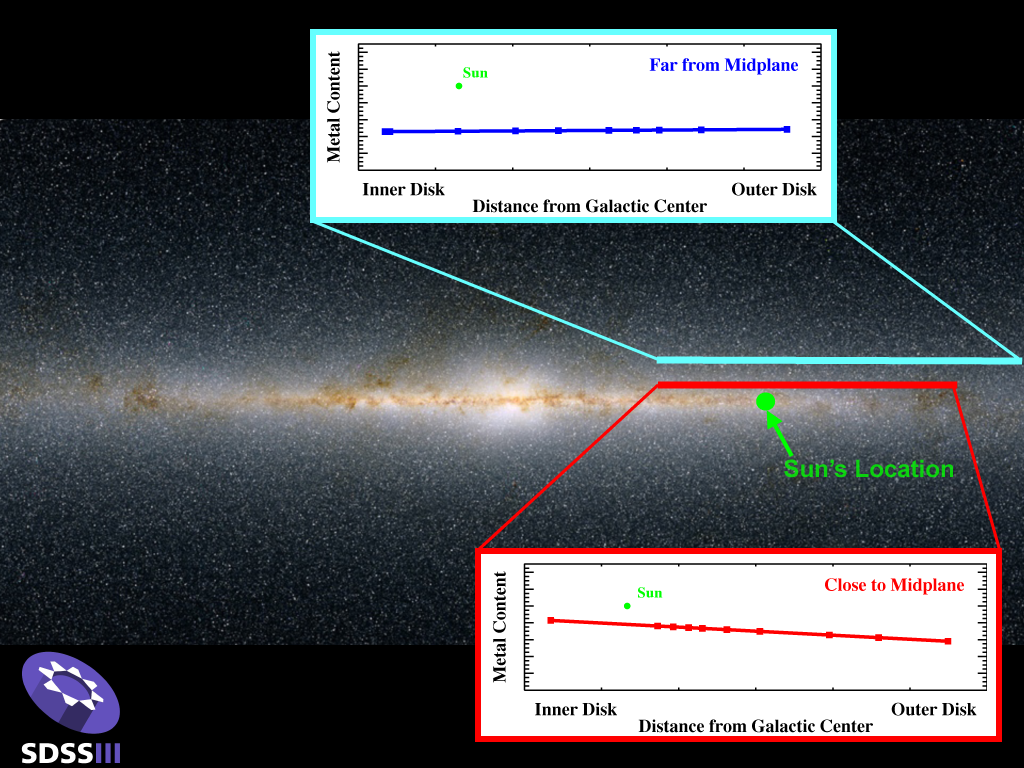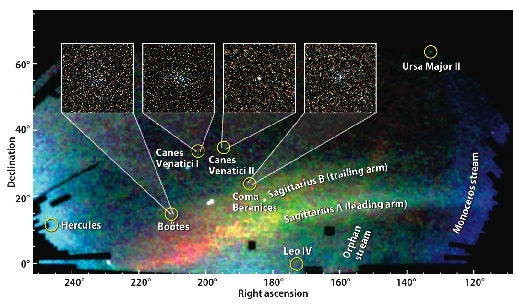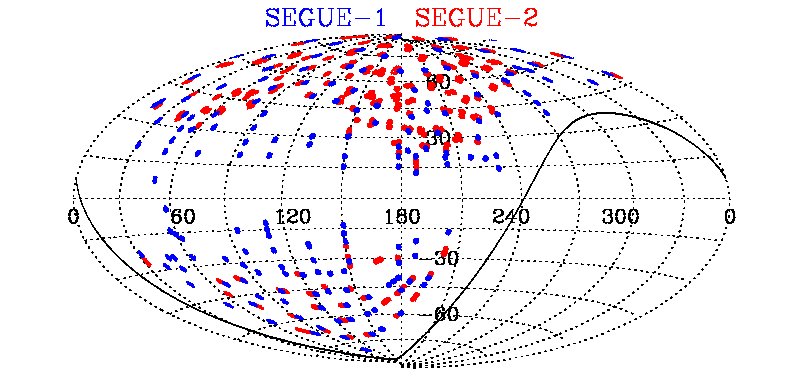SEGUE: Mapping the Outer Milky Way

The original Sloan Extension for Galactic Understanding and Exploration (SEGUE-1) obtained spectra of nearly 230,000 unique stars over a range of spectral types to investigate Milky Way structure. Building on this success, SEGUE-2 spectroscopically observed around 119,000 unique stars, focusing on the in situ stellar halo of the Galaxy, from distances of 10 to 60 kpc.
The complete spectral sample from SEGUE-1 and SEGUE-2 was available for SDSS-III DR8. Data Release 9 presented an updated version of the SEGUE Stellar Parameter Pipeline. It also included new Value-Added Catalogs. There have been no updates to SEGUE data or processing for subsequent data releases, but as SDSS data releases are cumulative, the DR9 SEGUE data is included in DR17.
Combining SEGUE-1 and 2 reveals the complex kinematic and chemical substructure of the Galactic halo and disks, providing essential clues to the assembly and enrichment history of the Galaxy. In particular, the outer halo is expected to be dominated by late-time accretion events. SEGUE can help constrain existing models for the formation of the stellar halo and inform the next generation of high resolution simulations of Galaxy formation. In addition, SEGUE-1 and SEGUE-2 help uncover rare, chemically primitive stars that are fossils of the earliest generations of cosmic star formation.
Much of what we know about the stellar halo comes from kinematically-selected stars in the solar neighborhood. In any cosmological scenario we expect the stellar halo to form inside out, with the outer halo increasingly dominated by recent accretion. SEGUE-2 capitalizes on the wide field and high throughput of SDSS instruments to focus on the more distant halo with the goal of understanding the growth of our stellar halo over time. Specific questions we hope can be addressed with the SEGUE-2 data include the fraction of the halo formed by the accretion of dwarf galaxies vs. in situ star formation, the accretion history of the halo through time, and whether the chemical abundance distribution of the more recently accreted, dynamically younger halo resembles the surviving dwarf galaxies, such that the differences between these dwarf galaxies and the halo observed in the solar neighborhood result from different accretion times. In addition, finding more halo stars is the most likely way to increase the number of tracers in the Galactic gravitational potential at large distances in order to better determine the total mass of the Galaxy.
- Date range
- Fall 2008 - Spring 2009
- Survey area
- 1317 deg2
- Number of stars
- 118,151
- Magnitude limit
- g < 19
To probe the extremes of the halo stellar population distribution, SEGUE-2 specifically targets blue horizontal branch stars, K-giants, and M-giants. Many important and rare halo tracers are impossible to survey in situ. Thus, those three stellar categories are complemented by a collection of main sequence turn off stars that cover a broad enough color range to include metallicities up to solar and is neither biased in metallicity or kinematics.
Additional local samples are used by SEGUE-2 to supplement the distant halo survey. Old, cool white dwarfs can be assigned ages from models in order to date Galactic field populations, as had been done with ultra-cool white dwarfs found in SDSS and SEGUE-1. Extreme and ultra-cool subdwarfs explore the low-mass end of the halo mass function and are sufficiently local to have good 3D kinematics. The cool subdwarfs and the extremely metal-poor star sample in particular will also be useful for studies of chemical evolution, nucleosynthesis, and stellar atmospheres. Finally, SEGUE-2 investigates halo high velocity stars and hypervelocity stars.
In selecting distant and rare objects, SEGUE-2 benefits from the experience of SEGUE-1 in developing optimized and efficient selection techniques. The SEGUE-2 selection methodology uses the most up to date color and proper motion cuts with SDSS DR7 photometry and astrometry to target particular spectral types. Additionally, the magnitude limits for SEGUE-2 use SEGUE-1 as a test case to achieve the optimal balance between survey depth, sky coverage, and data quality. Whereas SEGUE-1 matched shorter exposures of bright targets with long exposures of faint targets, SEGUE-2 obtains only deep pointings, as it focuses on the far reaches of our Galaxy.
For a thorough overview of SEGUE-1, see Yanny et al. 2009.
- Date range
- Winter 2004 - Winter 2008
- Survey area
- 1438 deg2 (3500 deg2 in Imaging)
- Number of stars
- 240,000
- Magnitude limit
- g < 19
SEGUE-1 was designed to explore the Milky Way structure; formation history; kinematics; dynamical evolution; chemical evolution; and dark matter distribution. The images and spectra obtained by SEGUE-1 allowed astronomers to map the positions and velocities of hundreds of thousands of stars, from faint, relatively near-by (within about 100 pc or roughly 300 light-years) ancient stellar embers known as white dwarfs to bright stellar giants located in the outer reaches of the stellar halo, more than 100,000 light-years away. Encoded within the spectral data are the composition and temperature of these stars, vital clues for determining the age and origin of different populations of stars within the Galaxy.

The primary goal of SEGUE-1 is a kinematic and stellar population study of the high-latitude thick disk and halo of the Milky Way. The halo is sampled sparsely with a series of seven deg2 tiles both in the SEGUE-1 imaging stripes and the main Legacy survey area, with centers separated by roughly 10 deg. Each such tile is sampled with two pointings, split at r=17.8, approximately the median target magnitude.
Half of the targets on each line of sight are devoted to sampling across various main sequence types, up to and including the main sequence turnoff. These are largely selected for spectroscopic follow up based on straightforward color-color and color-magnitude cuts. To this sample we add metal-poor main sequence turnoff stars selected by their blue ugr colors. These targets tend to be at a heliocentric distance of 10 kpc for [Fe/H] = -1.54. To reach to greater distances, SEGUE-1 samples field blue horizontal branch (BHB) stars, which extends to distances of approximately 40 kpc. Also reaching this distance is the sample of halo red giants.
The spectroscopic selection also includes smaller categories of rare but interesting objects. These include cool white dwarfs, which can be used to date the age of the Galactic disk, and high proper motion targets from the SUPERBLINK catalog, which have uncovered some of the most extreme M subdwarfs known and aided in the calibration of their metallicity scale using common proper motion pairs.

- Dark+Grey time observations
- Resolution R~2000, typical S/N=25
- Wavelengths 385-920 nm
- Velocity error 4 km/s
- Teff error* 117 K
- [Fe/H] error* 0.22 dex
- log g error* 0.26 dex
*These uncertainties depend on spectral type and signal to noise. The listed values are for stars with 4500 K ≤ Teff ≤ 7500 K. For more information, see the SSPP documentation.


